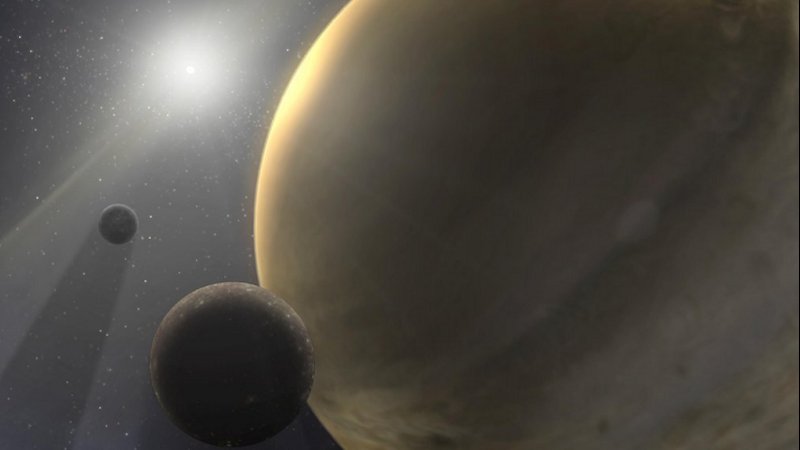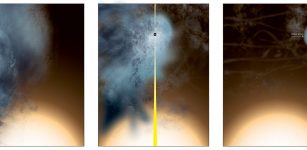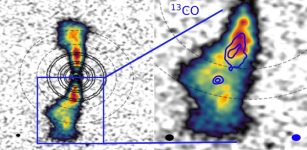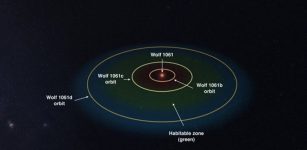TW Hydrae – A Star With Vast Quantities Of Water In Its Disk
MessageToEagle.com – The star with this waterlogged disk, called TW Hydrae, is 10 million years old and located about 175 light-years away from Earth, in the constellation Hydra. The frigid, watery haze detected by scientists is thought to originate from ice-coated grains of dust near the disk’s surface.
Ultraviolet light from the star causes some water molecules to break free of this ice, creating a thin layer of gas with a light signature detected by Herschel’s Heterodyne Instrument for the Far-Infrared, or HIFI.
This artist’s concept illustrates an icy planet-forming disk around a young star called TW Hydrae, located about 175 light-years away in the Hydra, or Sea Serpent, constellation. Astronomers using the Herschel Space Observatory detected copious amounts of cool water vapor, illustrated in blue, emanating from the star’s planet-forming disk of dust and gas. The water vapor, which probably comes from icy grains in the disk, is located in the frigid outer regions of the star system, where comets will take shape. In our own solar system, comets are thought to have carried water to Earth, creating our oceans. A similar process might be taking place around TW Hydrae — comets could, over the next several millions of years, transport water to young worlds. The Herschel results demonstrate that vast reservoirs of water are available around stars for creating these hypothetical water worlds. Credit: NASA, Caltech
The discovery was made using data from the Herschel Space Observatory. It is the first time astronomers have detected cold water vapor enveloping a dusty disk around a young star.
The findings suggest that this disk, which is poised to develop into a solar system, contains great quantities of water, suggesting that water-covered planets like Earth may be common in the universe. Herschel is a European Space Agency mission with important NASA contributions.
Scientists previously found warm water vapor in planet-forming disks close to a central star.
Evidence for vast quantities of water extending out into the cooler, far reaches of disks where comets take shape had not been seen until now.
The more water available in disks for icy comets to form, the greater the chances that large amounts eventually will reach new planets through impacts.
“Our observations of this cold vapor indicate enough water exists in the disk to fill thousands of Earth oceans,” said astronomer Michiel Hogerheijde of Leiden Observatory in The Netherlands.
“These are the most sensitive HIFI observations to date,” said Paul Goldsmith, NASA project scientist for the Herschel Space Observatory at the agency’s Jet Propulsion Laboratory in Pasadena, Calif. “It is a testament to the instrument builders that such weak signals can be detected.”
TW Hydrae is an orange dwarf star, somewhat smaller and cooler than our yellow-white sun.
The giant disk of material that encircles the star has a size nearly 200 times the distance between Earth and the sun. Over the next few million years, astronomers believe matter within the disk will collide and grow into planets, asteroids and other cosmic bodies. Dust and ice particles will assemble as comets.
This graph of data from Herschel shows how the cool water vapor was detected. Water molecules come in two “spin” forms, called ortho and para, in which the two spins of the hydrogen nuclei have different orientations. In this case, the team compared the ratio of ortho to para water seen in the TW Hydrae disk to that in comets, and found very low values. Lower ratios indicate cooler temperatures, though in practice the analysis is much more complicated. This is the first demonstration that water exists in large quantities in the frigid, outer regions of solar systems, where comets take shape. Credit: ESA/NASA/JPL-Caltech/Leiden Observatory
As the new solar system evolves, icy comets are likely to deposit much of the water they contain on freshly created worlds through impacts, giving rise to oceans. Astronomers believe TW Hydrae and its icy disk may be representative of many other young star systems, providing new insights on how planets with abundant water could form throughout the universe.
MessageToEagle.com












